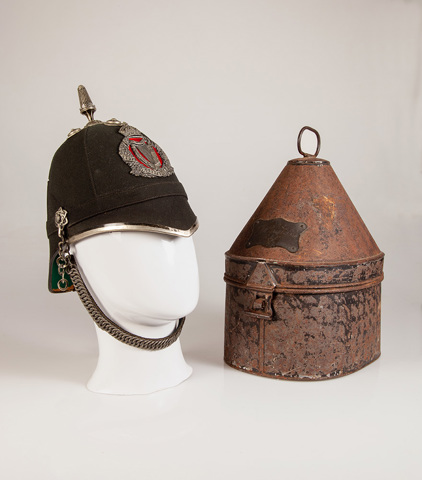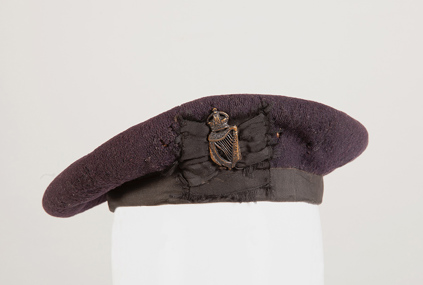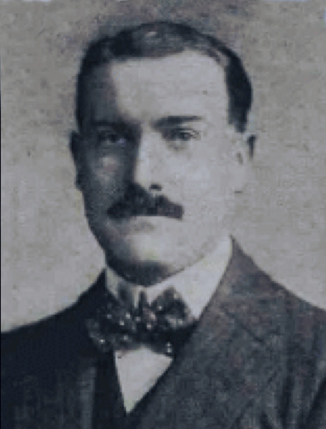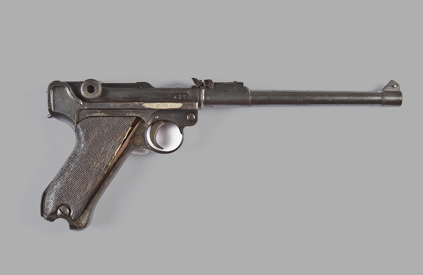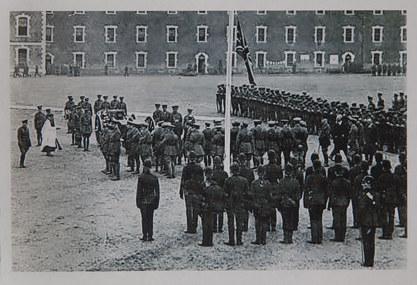
Royal Irish Constabulary
When the War of Independence commenced in January 1919, an armed police force known as the Royal Irish Constabulary (RIC) was responsible for policing all of Ireland with the exception of Dublin city, which was policed by the unarmed Dublin Metropolitan Police (DMP). The RIC had its origins in the Peace Preservation Force established by Sir Robert Peel, the Chief Secretary for Ireland in 1814. In 1836, a single force known as the Irish Constabulary was established. As a reward for its part in suppressing the Fenian Rising of 1867, Queen Victoria granted this force the right to use the prefix ‘Royal’.
(Above) Royal Irish Constabulary helmet and storage box
The RIC recruited in Ireland and, in January 1919, its strength was about 9,500. There were also some 1,300 RIC barracks in the country. Cork city was organised into a North and South District, each under the control of a District Inspector. The headquarters of the city and the South District was in Union Quay Barracks. Other barracks in this district were: the Bridewell, Blackrock, Blackrock Road, College Road, Togher, Tuckey Street and Victoria Cross. The headquarters of the North District was in King Street Barracks. Other barracks in this district were: Blackpool, Carrignavar, Commons Road, Lower Glanmire Road, Kilbarry, St. Luke’s, Shandon Street and Sunday’s Well. Barracks were also located in every town in the county. During the war, many of these barracks were attacked and destroyed by the IRA.
On 10 April 1919, Dáil Éireann passed a motion calling on people to socially ostracise the RIC. Early in the war, the IRA also adopted a strategy of targeting individual constables. These actions led to hundreds of resignations from the force and, in 1920, it was reinforced by personnel recruited in Britain who became known as the ‘Black and Tans’ and also by the Auxiliary Division of the RIC, which was comprised of ex-British military officers. In August 1922, the RIC was disbanded. It was replaced by the Garda Síochána in the Irish Free State and the Royal Ulster Constabulary in Northern Ireland.
(Above) Royal Irish Constabulary baton
British Army
The British Army was the largest and best equipped opponent faced by the IRA during the War of Independence. There were approximately 55,800 British soldiers located in Ireland during the conflict. These troops were based at a number of military barracks and posts situated throughout the country and were organised into units based on geographical areas of operation. The principal British formations in Ireland at that time were the 5th Division, the 6th Division, the Dublin District and the Ulster Brigade. Each of these formations contained a number of smaller units such as infantry, artillery and cavalry brigades and engineer, transport and signal companies. They also contained units from the ordnance, medical, and military police corps.
(Above) Civilians being rounded up by British forces in Macroom to fill in a road that was destroyed by the IRA in 1921
During the War of Independence, Victoria Barracks in Cork held the headquarters of the 6th Division. This unit had the province of Munster and the counties of Kilkenny and Wexford as its area of operations. It contained three infantry brigades, the 16th, 17th and 18th. The 17th Brigade was responsible for operations in Co. Cork. In addition to Victoria Barracks in Cork city, there were British Army garrisons in Ballincollig, Fermoy, Bantry, Kanturk, Kinsale, Bandon, Mallow, Kilworth, Buttevant, Ballyvonare, Moore Park and in forts Camden, Carlisle, Templebreedy and Westmoreland.
When the war commenced, the army acted primarily in support of the police. However, as the conflict continued, its powers would increase. In August 1920, the Restoration of Order in Ireland Act gave the military court-martial jurisdiction over all crimes committed in the country. On 10 December 1920, Martial Law was proclaimed in counties Cork, Kerry, Limerick, and Tipperary and from January 1921, the British Army was empowered to carry out ‘official’ reprisals. During the conflict, it mounted several successful operations against the IRA in Co. Cork, most notably at Dripsey, Upton, Clonmult, and Mourne Abbey. Despite this, and its superior firepower, equipment and mobility, by the time the Truce came into effect on 11 July 1921, the British Army had failed to defeat the IRA.
Black and Tans
The decision taken by Dáil Éireann on 10 April 1919, calling on the Irish people to socially ostracise members of the RIC and the numerous IRA attacks led to hundreds of resignations and retirements from the force. There was also a fall in the number of new recruits in Ireland. This shortage in manpower led police authorities to abandon many rural RIC barracks. In an effort to deal with this situation, the British government decided to recruit members for the RIC in Britain. On 27 December 1919, T. J. Long, the Inspector General of the RIC, gave the necessary authorisation and the first British recruits, officially known as the RIC Special Reserve, joined the following month.
In February 1920, the new recruits started arriving in Ireland. Because of a clothing shortage, they were clad in a mixture of khaki British Army and dark green RIC uniforms. This earned them the nickname ‘Black and Tans’ after the Kerry Beagles of the Scarteen Hunt. Initially trained in Hare Park Camp in the Curragh, Co. Kildare, and later at Gormanstown Camp, Co. Meath, the Black and Tans were deployed to barracks throughout the country. Comprised of ex-servicemen who received rudimentary police training, they quickly proved ineffective and gained a reputation for ill-discipline, drunkenness and casual violence. The first Black and Tans arrived in Cork city in March 1920 and some, such as Constable Stephen Chance, who was based in Shandon Street RIC Barracks, became particularly notorious for their cruelty and the way they terrorized the civilian population.
(Above) Newspaper clipping from the Black and Tans warning of reprisals
In all, almost 11,000 individuals, around 890 of whom were Irish born, joined the Black and Tans. In addition to the RIC Special Reserve, this number includes temporary constables and members of the Veterans and Drivers Division. After the RIC was disbanded in August 1922, many Black and Tans became unemployed while others joined the Royal Ulster Constabulary and the Palestine Police Force.
Auxiliary Division, Royal Irish Constabulary
On 11 May 1920, the British government met to consider the situation in Ireland. Despite the recent deployment of the Black and Tans, IRA operations were on the increase. At the meeting, Winston Churchill, the Secretary of State for War, suggested the establishment of a ‘Special Emergency Gendarmerie, which would become a branch of the Royal Irish Constabulary’. Although his suggestion was rejected by a committee chaired by General Macready, the commander of British Forces in Ireland, it was revived the following July by Major-General Tudor, the Police Adviser to the Dublin Castle Administration.
(Above) Balmoral type cap/hat from the Auxiliary Police
Known as the Auxiliary Division of the RIC (ADRIC), and commanded by Brigadier-General Frank Crozier, the force would consist of former military officers recruited in Britain. Successful applicants would be paid £7 per week and given the rank of ‘temporary cadet’ but those selected to be Auxiliary officers were given the same rank as their RIC counterparts. Recruiting commenced in July 1920, and on completion of a six-week police course, the Auxiliaries were assigned to alphabetically designated companies located in areas with high levels of IRA activity. Dressed in a RIC uniform or their old army uniforms with appropriate police badges, all Auxiliaries wore a distinctive Tam O’ Shanter cap. Though nominally under the command of the RIC, many Auxiliary companies acted independently and the force soon gained a reputation for drunkenness, ill-discipline, and brutality worse than that of the Black and Tans.
(Above) Group of Black and Tans and Auxiliaries near Union Quay RIC barracks, Cork
Five Auxiliary companies were deployed in Co. Cork during the War of Independence: J Company in Glengarriff and Macroom; K Company in Cork city and Dunmanway; L Company in Millstreet and O Company in Dunmanway. K Company, which was under the command of former Royal Air Force Officer, Lieutenant Colonel Owen Latimer, and based in Victoria Barracks, was responsible for the arson attack known as the Burning of Cork (11/12 December 1920). In all, around 2,200 men served in the ADRIC. The force was disbanded along with the rest of the RIC in August 1922.
Crown Forces-Biographies
Major Geoffrey Lee Compton-Smith
2nd Battalion, Royal Welch Fusiliers
Geoffrey Lee Compton-Smith was born on 19 August 1889 in South Kensington, London, the son of William and Henrietta Compton-Smith. A graduate of the Royal Military College, Sandhurst, he was commissioned into the Yorkshire Regiment but in June 1915 he transferred to the Royal Welch Fusiliers. During the First World War, he commanded the 10th Battalion of that regiment and was wounded. He was also Mentioned in Despatches and was awarded the Distinguished Service Order (DSO) and the French Légion d'honneur. In 1916, he married Gladys Lloyd and the couple had one child, a daughter, Anne.
(Above) British military bayonet c.1920.
After the war, Major Compton-Smith was appointed camp commandant of Ballyvonare Camp near Buttevant, Co. Cork. On 16 April 1921, he was captured outside Blarney by an IRA unit led by Frank Busteed. Four IRA Volunteers were due to be executed in the Military Detention Barracks in Cork on 28 April and the IRA decided to hold Compton-Smith hostage in an effort to prevent their death. The British military authorities in Cork were informed that if the Volunteers were shot, then Compton-Smith would be executed.
(Above) British army compass, c.1920.
Compton-Smith was detained in a number of houses in Donoughmore. When the Volunteers were shot on 28 April, he was executed two days later. His remains were initially buried in Barrahaurin bog. However, in 1926, they were exhumed and reburied in the British military cemetery outside Fort Carlisle, Co. Cork. During his captivity, Compton Smith developed a good relationship with his captors and he spoke well of them in the last letters he wrote before his death. He is believed to have been the inspiration for the short story,Guests of the Nation, written by the Cork author Frank O’Connor.
District Inspector Oswald Ross Swanzy
Royal Irish Constabulary
The son of solicitor James and Elizabeth Swanzy (née Ross), Oswald Ross Swanzy was born in Castleblaney, Co. Monaghan, on 15 July 1881. He joined the Royal Irish Constabulary (RIC) as a cadet on 28 February 1905. On completion of his training at the RIC Deport in the Phoenix Park in Dublin, he was promoted 3rd Class District Inspector. He went on to serve at Rathkeale, Co. Limerick, and at Carlow.
In January 1916, Swanzy was appointed RIC District Inspector for Cork City North and was based in the RIC Barracks on King Street. He was soon involved in a number of investigations and arrests of republican suspects. The IRA also believed that he played a major part in the killing of Lord Mayor Tomás Mac Curtáin who was shot dead at his home at 40 Thomas Davis Street in Blackpool in the early hours of 20 March 1920.
(Above) `Alleged Lugar used in the execution of Swanzy.
Following the death of Mac Curtáin, the RIC transferred Swanzy to Lisburn. However, Seán Culhane, an IRA intelligence officer with Cork No. 1 Brigade learned of his location when he found a hat box with his name on it at the Glanmire Road railway station. When it received this information, IRA Headquarters in Dublin decided to execute Swanzy and members of Cork No. 1 Brigade were authorised to carry out the operation. On 22 August 1920, an IRA squad which included Seán Culhane and Dick Murphy from Cork and Roger McCorley from the Belfast Brigade shot Swanzy dead as he was coming from Christchurch Cathedral in Lisburn. After he was killed, serious sectarian rioting erupted in Lisburn and a number of Catholic homes and businesses were destroyed.
Lieutenant Colonel Gerald Bryce Ferguson Smyth
Royal Irish Constabulary
Gerald Bryce Ferguson Smyth was born on 7 September 1885, in Dalhousie, India, He was the son of George and Helen Smyth (née Ferguson). In 1905, he was commissioned into the Royal Engineers. During the First World War, he was awarded the Distinguished Service Order and Bar, the French Croix de Guerre and the Belgian Croix de Guerre. He was also wounded six times, losing his left arm in October 1914. In December 1916, he took command of a battalion of King's Own Scottish Borderers which was part of the 9th (Scottish) Division commanded by Brigadier General Henry Hugh Tudor. He ended the war as a Brevet Lieutenant General in command of the 93rd Infantry Brigade.
In May 1920, General Tudor, now police adviser to the civil administration in Ireland, recommended Smyth for the position of RIC divisional commissioner for Munster. After taking up that appointment, Smyth issued a series of radical counter-insurgency instructions designed to suppress the IRA campaign in the province. On 19 June 1920, he arrived at the RIC Barracks at Listowel, Co. Kerry, accompanied by Tudor. While there, he gave an inflammatory speech that infuriated some members of the garrison and led to the incident known as the ‘Listowel Mutiny’.
(Above) Possible funeral of Ferguson-Smyth at Victoria Barracks (now Collins Barracks).
The IRA now considered Smyth to be a major threat and a decision was taken to eliminate him. On the night of 17 July 1920, an IRA unit led by Dan ‘Sandow’ O’Donovan, entered the County Club on the South Mall in Cork and shot him dead. The killing of Smyth led to clashes between civilians and Crown forces in Cork, the expulsion of Catholics from Belfast shipyards and a series of sectarian attacks in Banbridge, Co. Down.
(Above) Royal Irish Constabulary station/barracks external plaque
Major Arthur Percival
1st Battalion, Essex Regiment
Arthur Ernest Percival was born on 26 December 1887 at Aspenden Lodge in Hertfordshire, England, the second son of Alfred Reginald and Edith Percival (née Miller). Educated at Rugby, he joined the Officer Training Corps of the Inns of Court on the outbreak of the First World War and he was promoted 2nd Lieutenant after five weeks training.
In 1915, Percival deployed to France with the 7th (Service) Battalion of the Bedfordshire Regiment. In September 1916, he was badly wounded leading at attack on the Schawben Redoubt and the following month, he transferred to the Essex Regiment. During the war, he was awarded the Distinguished Service Order, the Military Cross and the French Croix de guerre.
(Above) The opening of the Cork Assizes (higher criminal court), now the Washington Street courthouse 1920.
In 1920, Percival was sent to West Cork to join the 1st Battalion of the Essex Regiment as a company commander. However, he later became the battalion intelligence officer. Tom Barry, the commander of the Flying Column of Cork No. 3 Brigade of the IRA, stated that Percival was ‘easily the most vicious anti-Irish of all serving British officers’. In the summer of 1920, Percival captured Tom Hales, commander of Cork No. 3 Brigade and Patrick Harte, the brigade quartermaster. Both men were badly tortured during their interrogation. Harte never recovered from this ordeal and died in 1925. Percival was appointed to the Order of the British Empire (OBE) for their capture. Though targeted by the IRA, he survived the War of Independence unscathed. During the Second World War, Percival was appointed General Officer Commanding Malaya and became known as the officer who surrendered Singapore to the Japanese Army on 15 February 1942. He died in King Edward VII's Hospital for Officers in London on 31 January 1966.
Major Bernard Law Montgomery
Brigade Major, 17th Infantry Brigade
Born in Kennington, Surrey, on 17 November 1887, Bernard Law Montgomery was the son of Henry and Maud Montgomery (née Farrar). His father was an Anglican vicar and in 1889 he was appointed Bishop of Tasmania. After the family returned to London in 1901, Montgomery attended St. Paul’s School before entering the Royal Military Academy at Sandhurst. In 1908, he was commissioned into the 1st Battalion of the Royal Warwickshire Regiment as a 2nd lieutenant. During the First World War, Montgomery served on the Western Front with that regiment and held a number of staff appointments. He was also shot in the lung by a sniper and was awarded the Distinguished Service Order for leadership under fire.
(Above) In the village of Meelin Co. Cork on the 6th January 1921, the male population is rounded up for questioning by British forces
In January 1921, after graduating from Staff College, Montgomery was sent to Victoria Barracks in Cork to take up the position of brigade major with the 17th Infantry Brigade. The previous November, his cousin, Lieutenant Colonel Hugh Montgomery, was killed by the IRA in Dublin. As a brigade major, Montgomery was responsible for planning the unit’s counter-insurgency operations. He would remain in Victoria Barracks until it was evacuated by the British Army on 18 May 1922. During his time in Cork, he produced a comprehensive set of operational orders that were designed to improve the efficiency of the British Army campaign against the IRA.
In the Second World War, Montgomery rose to the rank of field marshal. He also became famous as the man who defeated Field Marshal Rommel at the Battle of El Alamain in 1942 and he commanded the Allied landings at Normandy in 1944. Bernard Law Montgomery died on 24 March 1976 and is buried in Holy Cross churchyard, in Binsted, Hampshire, England.
Major General Sir Edward Peter Strickland
6th Division, British Army
Edward Peter Strickland was born on 3 August 1869 at Snitterfield, Warwickshire, England, the son of Frederick and Frances Strickland. In 1888, he was commissioned into the Norfolk Regiment and went on to serve in Upper Burma (1888-89) and with the Egyptian Army (1889-1905). He also served in India and Nigeria. During the First World War he served on the Western Front as commander of the 1st Battalion, Manchester Regiment, the Jullundur Brigade, the 98th Brigade and the 1st Division. He led that division during the battles of the Somme and Passchendaele, the 1918 German Spring Offensive and the final British offensive known as the ‘Hundred Days’
After the end of the war, Strickland became commander of the Western Division of the British Army of the Rhine. In 1919, he was appointed General Officer Commanding (GOC) the 6th Division in Ireland. This unit had the province of Munster together with the counties of Kilkenny and Wexford as its area of operations and its headquarters was located in Victoria Barracks in Cork.
(Above) Notice Prohibiting Public Meetings signed by General Strickland for Middleton 1920.
On 24 September 1920, the IRA attacked Strickland’s staff car at the bottom of St. Patrick’s Hill in Cork in an unsuccessful attempt to capture him and hold him hostage to secure the release of Lord Mayor Terence MacSwiney who was then on hunger strike in Brixton Prison. Strickland became the Military Governor of counties Cork, Kerry, Limerick and Tipperary when the British Government declared Martial Law in those counties on 10 December 1920. He remained in command of the 6th Division until it withdrew from Ireland in 1922. Strickland retired from the army in 1931. He died at his home at Snettisham, Norfolk, on 24 June 1951.


